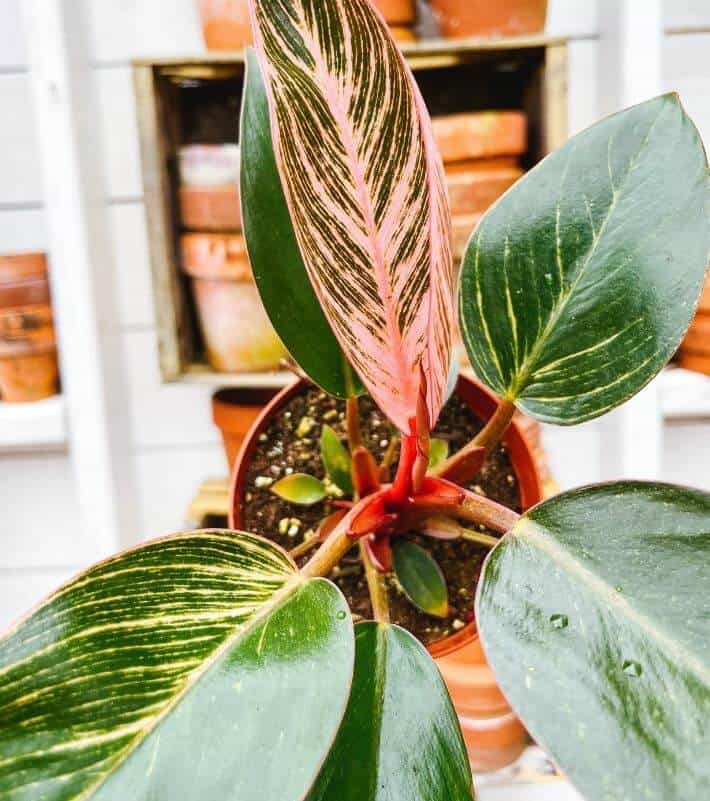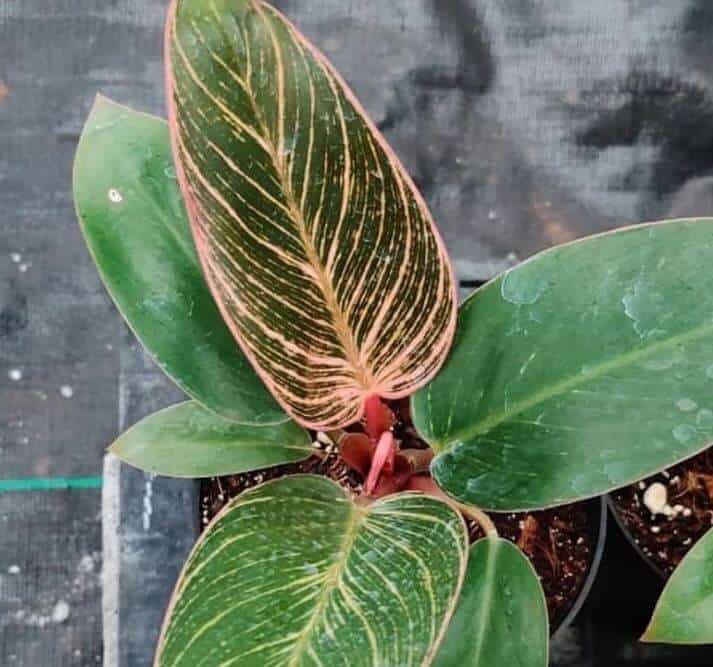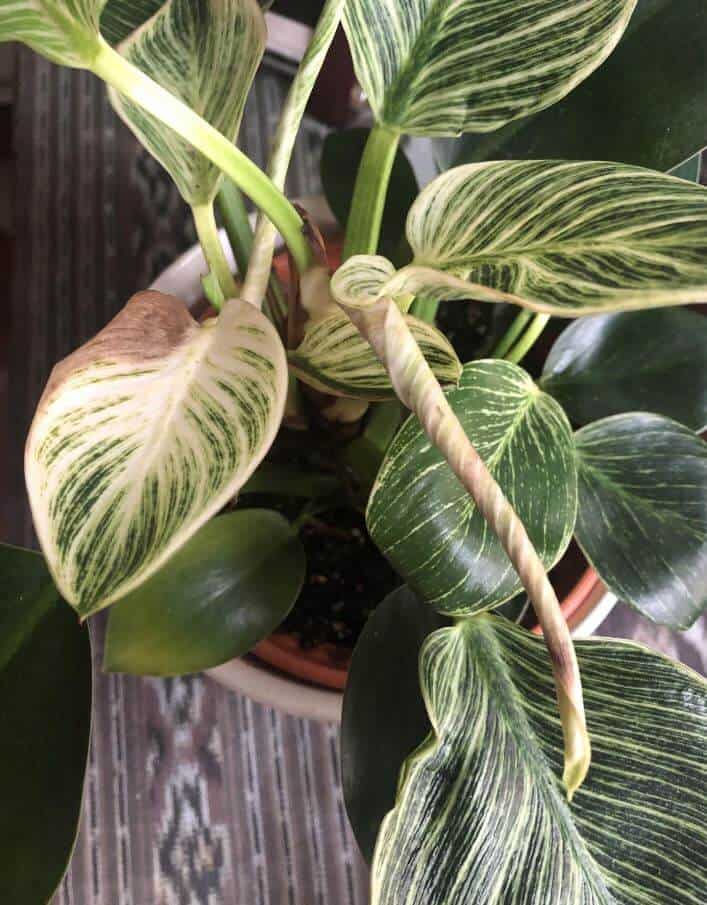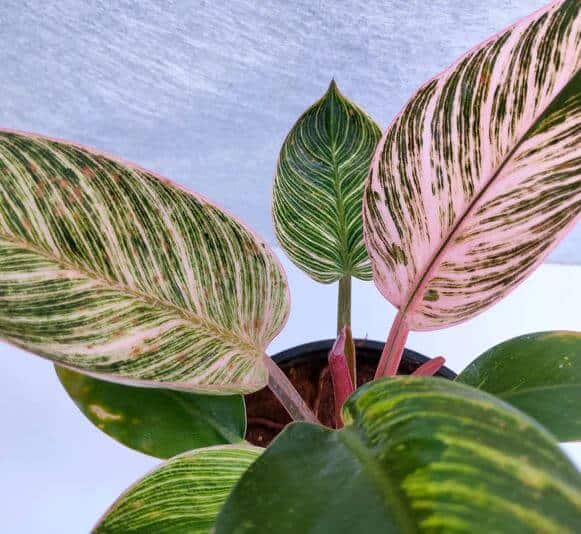Last Updated on January 6, 2023 by a Friendly Gardener
The Birkin pink plant is better known as the Philodendron Birkin. It’s a good-looking plant that doesn’t have any ancient history. It’s fairly new and has dark green leaves with a few vivid pink pinstripes, hence the name.
This plant has a large shape and is better grown indoors. It’s a variegated plant that’s the result of a Philodendron Rojo Congo mutation. It is a houseplant that acquires the pink shades on the dark green leaves only after it matures.
The plant is propagated through its leaves but the Philodendron Birkin is generally considered unstable because the mutation can go back to looking like the parent plant.
Pink Birkin Plant Care

Originally, this is a tropical plant that is quite easy to care for. And beginners like it because when the plant is not well taken care of, you can see it and fix the situation. But it’s important not to have pets around this plant since the stems and leaves have toxic calcium oxalate crystals.
Light
These plants need a lot of bright but indirect light. So, it’s okay to keep them next to a window but make sure they are not exposed to sunlight directly. If you do, the leaves will burn and the soil will dry up. But if it doesn’t get enough light, the leaves will turn pale.
So, make sure that the plant gets about 12 hours of bright and indirect light. The other reason why this is an indoor plant is that it should be grown in an environment that’s a bit humid.
Water
This plant doesn’t need a lot of water, especially in the summer and spring. So, you only need to check the leaves and soil and water it once a week. And when the weather gets cold, you need to water it only once every two weeks. But you must check the soil beforehand and if the top inch is not dry, you can spritz the leaves a bit.
This plant can deal with drought but not with excess water. So, if you want to err on the side of caution, you want to skip a watering session and not increase it.
Soil

This plant grows well when the soil is moist and drains well. So, the regular potting mix is a good option and you can add some perlite to it. There is also the option of adding some organic compost or peat moss so that the soil remains moist.
Adding peat moss or perlite will also stop the clumping of the soil, which is good. And if you can find some, adding some sphagnum moss isn’t a bad idea.
Pruning
These plants don’t need to be pruned unless there are damaged or dead leaves. In fact, if you spot yellow leaves, you can leave them be if they are the result of aging and not bad care.
Fertilizing
In their growing season, which is the summer and spring, you can add fertilizer once every two to four weeks. Make sure it is water-soluble, organic compost or mulch so that the soil can retain moisture. If you add too much mulch it could get in the way of drainage, and that’s not good.
Growth Conditions

Since these are tropical plants, they grow well in a humid atmosphere. The ideal temperature for the growth of this plant is between 18 and 30 degrees. In any case, make sure the temperature of the room is never less than 13 degrees.
The room also shouldn’t have strong winds or even a draft. The room should have 40 to 70 percent humidity. And you can create this by misting the plant from time to time. Putting it next to other houseplants is also a good way to do so.
Repotting

This plant grows quite quickly when the conditions are favorable. So, you want to change the pot every two years. Make that decision at the end of the growing season. Repotting this plant is usually an annual exercise after you see the roots growing out.
Get a planter that is 0.9 to 1.9 inches bigger than the existing pot and has drainage holes. This way, it will have a lot of space to keep growing, but you won’t have to worry about overwatering.
Pest and Disease Control
Speaking of overwatering, root rot is a real threat to this plant. This is usually caused by overwatering, soil that doesn’t drain well, pots that are too big, or temperature being too low.
Any and all of these problems will lead to excess moisture in the soil and the rotting of the roots. You will know there’s a problem if you see stunted growth, discolored leaves, or soggy soil. The roots might also be black or white and be mushy.
You can fix this by taking the plant out of the pot and cleaning the roots with running water. Then you should change the soil and trim the roots to remove the affected parts. Replant it and see how it grows.
Overwatering can also lead to spots on the leaves, which is the result of bacterial infections.
And then there’s pest control.
If you don’t take good care of the plant, spider mites will invade the plant. They are usually red-brown in color and suck the nutrients out of the plant. As a result, the leaves will become dry and fall from the plant.
You can remove them using a spray of water or a damp cloth, depending on the intensity of the infection. After that, you must remove the worst-affected leaves and clean the plant with insecticide soap.
Thrips are another common pest that attacks Birkin plants. They are small and in black or pale yellow color. They are bug-like and turn the plant splotchy and pale at the scale of an infestation.
The treatment is the same as with spider mites. Clean the plant with insecticide soap and prune the affected parts.
Conclusion
The pink Birkin plant care is actually not so much of a guide because it’s so easy to take care of this plant. For the most part, you just need to make sure that it’s not getting burnt in the sun or drowning due to overwatering.


